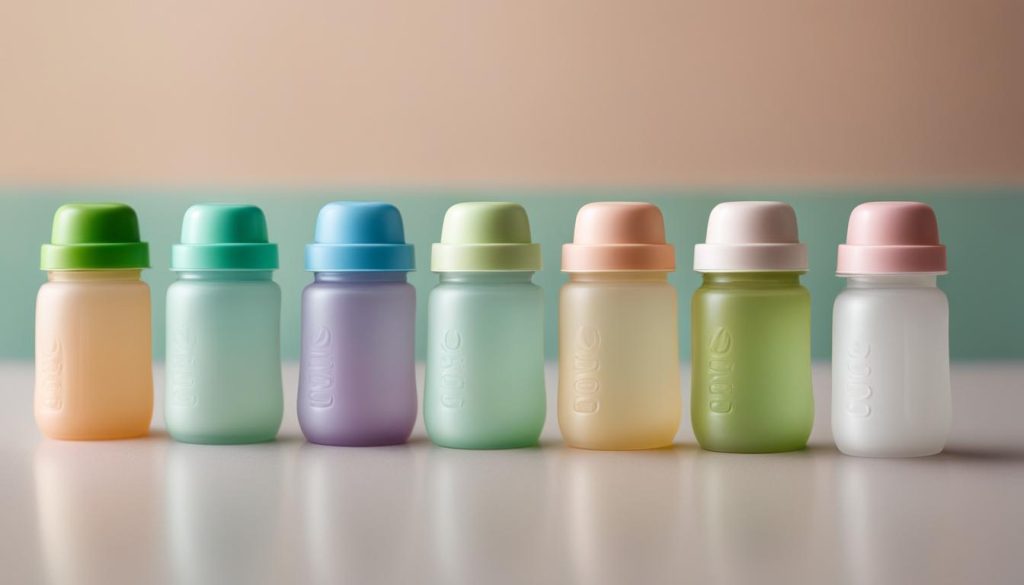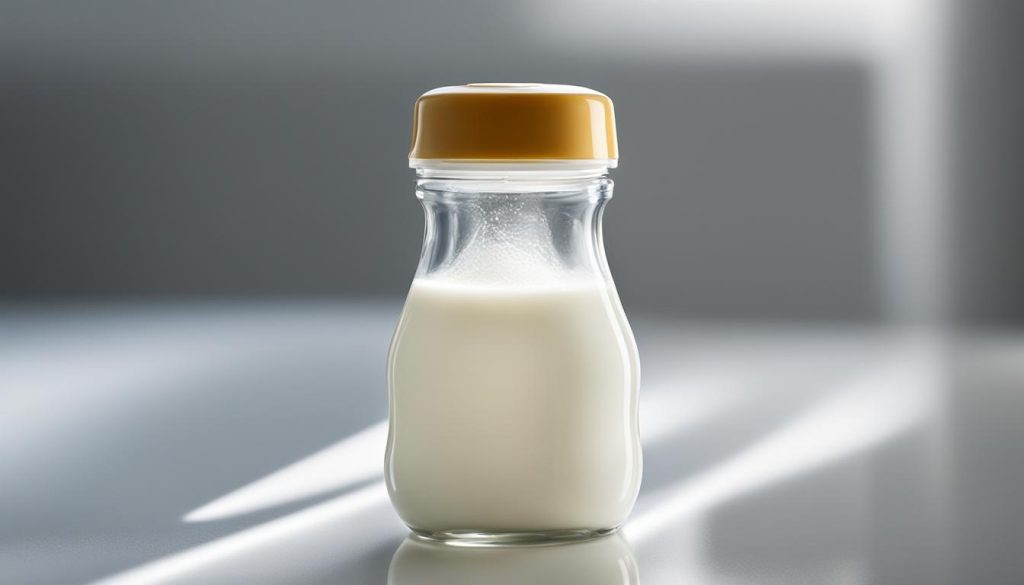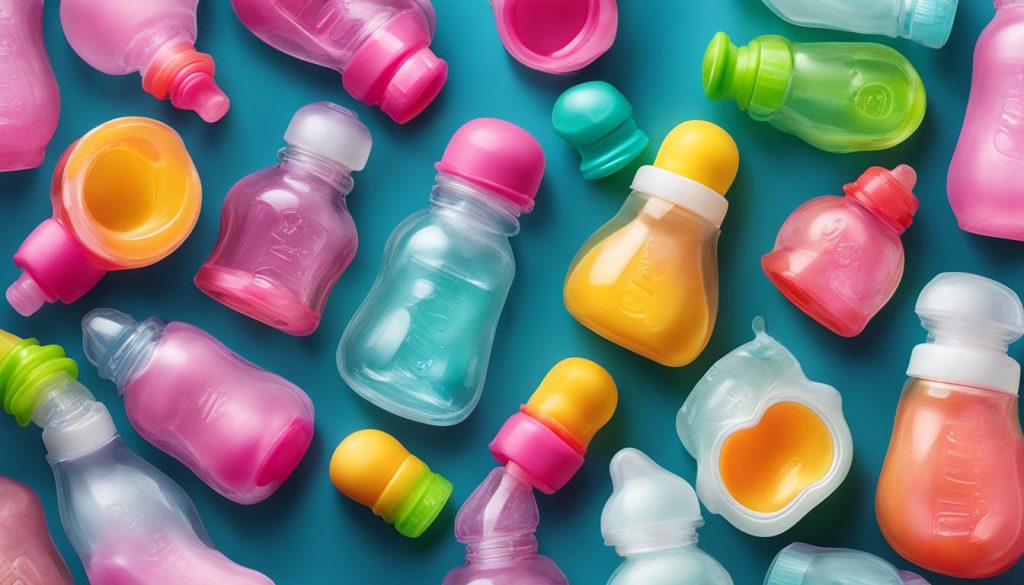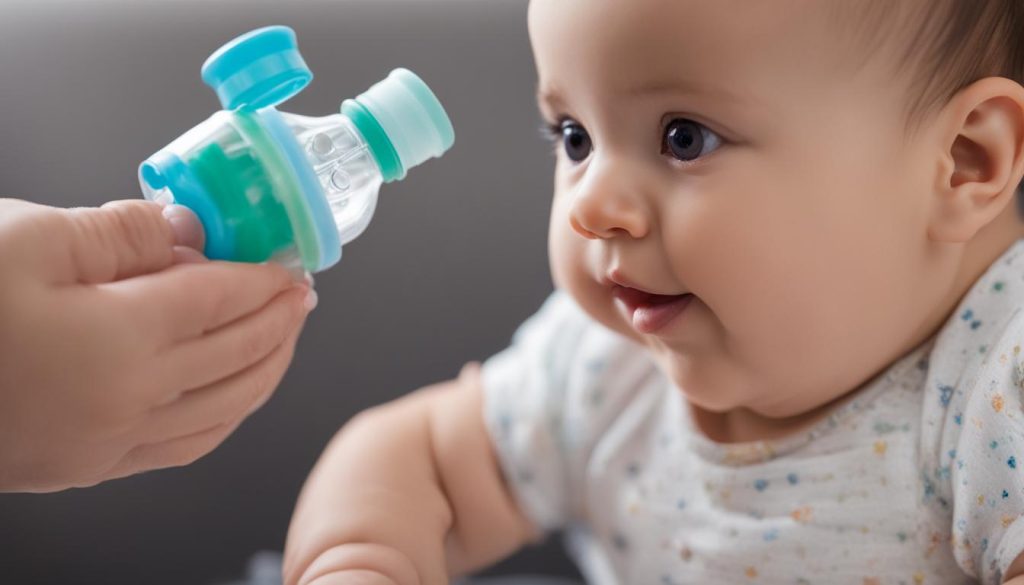When it comes to choosing the right baby bottle for your little one, there are various factors to consider. This includes the type of nipple, size of the bottle, and material used. Navigating these choices can be overwhelming, but by understanding the different baby bottle nipple types, you can find the perfect fit for your baby’s unique feeding needs.
As a parent, you may have come across terms like slow flow, medium flow, and fast flow when shopping for baby bottle nipples. These terms refer to the different speeds at which milk or formula flows through the nipple. Slow flow nipples are ideal for newborns or infants who require a slower milk flow. Medium flow nipples are suitable for older babies who can handle a slightly faster flow. Fast flow nipples are designed for older, more experienced eaters who can handle a quicker milk flow.
In addition to flow rate, there are other types of baby bottle nipples to consider. Anti-colic nipples are designed to reduce the intake of air during feedings, helping to prevent discomfort and colic in your baby. Orthodontic nipples are shaped to mimic a mother’s breast, promoting proper oral development.
When choosing the right bottle nipple for your baby, it’s important to consider their age, feeding style, and preferences. While slow flow nipples are generally recommended for newborns, some babies may require a different flow rate based on their individual needs. By observing your baby’s feeding habits and looking for signs of readiness for a different nipple size or flow rate, you can ensure comfortable and efficient feeding.
Baby bottle nipples are typically made of either silicone or latex material. Silicone nipples are clear, durable, and easily sterilized. However, latex nipples may cause allergic reactions in some infants, so it’s important to consult with your doctor before using them. When it comes to bottle materials, there are options like glass, plastic, and silicone bottles. Glass bottles are durable, easy to clean, and free from potentially harmful chemicals found in plastic bottles. Plastic bottles are lightweight and affordable but may require frequent replacement. Silicone bottles offer durability and safety, combining the benefits of both glass and plastic.
Proper maintenance and sterilization of baby bottles are essential for your baby’s health and safety. After each feeding, bottles should be thoroughly cleaned with warm soapy water or placed in a dishwasher. It’s also important to pay attention to any residue or milk buildup in the bottle and nipples and clean them properly. Additionally, bottles should be sterilized regularly, especially for newborns or babies with weakened immune systems. This can be done by boiling the bottles in water or using a sterilizer specifically designed for baby bottles.
In conclusion, choosing the right baby bottle nipple is crucial for your baby’s comfort and feeding experience. By understanding the different types of bottle nipples and considering factors like flow rate, material, and maintenance, you can ensure a happy and healthy feeding journey for your little one.
Types of Baby Bottle Nipples
When it comes to feeding your baby, choosing the right bottle nipple is crucial. There are various types of baby bottle nipples available, each designed to meet different feeding preferences and needs. Understanding the differences between these nipple types can help you select the perfect fit for your little one.
Slow Flow Bottle Nipple
A slow flow bottle nipple is ideal for newborns or infants who require a slower milk flow. These nipples have a smaller opening, which helps control the rate at which milk or formula is released. Slow flow nipples mimic the natural flow of breastfeeding, allowing your baby to comfortably and easily feed.
Medium Flow Bottle Nipple
As your baby grows, they may require a slightly faster flow. Medium flow bottle nipples are designed for older babies who can handle a slightly increased milk flow. These nipples have a larger opening compared to slow flow nipples, allowing milk to flow at a moderate rate.
Fast Flow Bottle Nipple
For older, more experienced eaters, fast flow bottle nipples are the best option. These nipples have an even larger opening, allowing for a quicker milk flow. Fast flow nipples are suitable for babies who can handle a faster pace of feeding without getting overwhelmed.
Anti-Colic Bottle Nipple
Some babies may experience discomfort or colic during feeding due to swallowing air. Anti-colic bottle nipples are designed with special features, such as venting systems or air vents, to help reduce air intake during feedings. These nipples can help minimize gas, colic, and fussiness, ensuring a more comfortable feeding experience for your baby.
Orthodontic Bottle Nipple
Orthodontic bottle nipples are shaped to mimic the natural shape of a mother’s breast. These nipples promote proper oral development by encouraging correct tongue positioning and jaw movement. Orthodontic nipples can help prevent nipple confusion for breastfed babies and promote healthy oral habits.
Choosing the right baby bottle nipple is essential for your baby’s comfort and feeding experience. Consider your baby’s age, feeding preferences, and any specific needs they may have. Observing your baby’s feeding habits and consulting with healthcare professionals can also provide valuable guidance in selecting the most appropriate nipple type.
Choosing the Right Bottle Nipple
Choosing the right bottle nipple for your newborn is a crucial decision that can greatly impact their feeding experience. Every baby is unique, and their specific needs and preferences should be taken into consideration. When selecting a bottle nipple, there are a few factors to keep in mind:
- The flow rate: Newborns typically require a slow flow nipple to mimic the natural pace of breastfeeding. This ensures that they can comfortably and easily drink their milk without feeling overwhelmed. However, some babies may show signs of being ready for a faster flow, such as taking longer to finish their bottle or seeming frustrated during feedings. If this is the case, you may want to consider transitioning to a medium flow nipple.
- Your baby’s feeding style: Some babies have a more aggressive or relaxed feeding style, and this can affect their preference for a certain nipple. Observing how your baby latches onto the nipple and their overall feeding behavior can help you determine the right nipple shape and texture for them.
- Your baby’s comfort: It’s important to choose a nipple that your baby can easily latch onto and suckle without any discomfort. Nipples come in various shapes and materials, such as silicone or latex. It may be helpful to try different options to see which one your baby responds to best.
Remember that it may take some trial and error to find the best bottle nipple for your newborn. Pay attention to their cues and adjust the nipple as needed. Consulting with your pediatrician or a lactation specialist can also provide valuable guidance in choosing the right bottle nipple for your baby’s specific needs.
| Flow Rate | Bottle Nipple Type | Recommended Age |
|---|---|---|
| Slow flow | Ideal for newborns | 0-3 months |
| Medium flow | For older babies | 3-6 months |
| Fast flow | Suitable for experienced eaters | 6+ months |
Keep in mind that every baby is different, and these are general guidelines. Your baby’s individual needs may vary, so it’s important to be attentive to their feeding cues and adjust the nipple accordingly. By choosing the right bottle nipple, you can ensure a comfortable and enjoyable feeding experience for your little one.
Bottle Nipple Materials and Sizes
When choosing a baby bottle nipple, it’s important to consider both the material used and the appropriate size for your baby’s needs. The material of the nipple can play a role in durability, safety, and ease of cleaning, while the size determines how much milk or formula flows through the nipple during feeding.
Bottle Nipple Materials
There are various materials commonly used in baby bottles, each with its own advantages and considerations. The most popular options are:
- Glass baby bottles: Glass bottles are known for their durability and ability to withstand high temperatures. They are easy to clean and are free from potentially harmful chemicals found in some plastics. However, they may be heavier compared to other options.
- Plastic baby bottles: Plastic bottles are lightweight and affordable. They are also shatterproof, making them a convenient choice for on-the-go parents. However, it’s important to ensure that the plastic used is BPA-free to avoid potential health risks.
- Silicone baby bottles: Silicone bottles offer the best of both worlds, combining the durability of glass bottles with the lightweight nature of plastic bottles. They are also easy to clean and are free from harmful chemicals. However, they can be more expensive than other options.
Before making a decision, it’s important to consider your own preferences and any specific concerns regarding the materials used in baby bottles. Consulting with your pediatrician can also provide valuable guidance.
Bottle Nipple Sizes
The size of the bottle nipple refers to the flow rate or the amount of milk or formula that the nipple allows to pass through. It’s important to choose the right size to ensure comfortable and efficient feeding for your baby. The available sizes typically include slow flow, medium flow, and fast flow nipples.
Slow flow nipples: These nipples are designed for newborns or young infants who require a slower milk flow. They mimic the pace of breastfeeding and can be beneficial for babies who are transitioning from breast to bottle feeding.
Medium flow nipples: These nipples are suitable for older babies who can handle a slightly faster flow of milk or formula. They are often recommended for babies who are around three to six months old.
Fast flow nipples: These nipples are designed for older, more experienced eaters who can handle a quicker milk flow. They are typically recommended for babies who are over six months old.
It’s important to note that every baby is unique, and their feeding needs may vary. Pay attention to your baby’s cues and consult with your pediatrician if you’re unsure about the appropriate nipple size for your little one.
| Nipple Material | Advantages | Considerations |
|---|---|---|
| Glass | Durable, easy to clean, free from harmful chemicals | Heavier compared to other options |
| Plastic | Lightweight, affordable, shatterproof | Ensure BPA-free plastic is used |
| Silicone | Durable, lightweight, easy to clean, free from harmful chemicals | Relatively more expensive |
Bottle Maintenance and Sterilization
Proper maintenance and sterilization of baby bottles are essential for your baby’s health and safety. Ensuring that bottles are clean and free from bacteria or residue is crucial to prevent any potential harm to your little one’s delicate immune system. Here are some important tips for bottle maintenance, sterilization, and cleaning:
Cleaning Baby Bottles
After each feeding, it’s important to thoroughly clean baby bottles to remove any leftover milk, formula, or food particles. Start by disassembling the bottle, separating the nipple, bottle ring, and bottle itself. Rinse all parts with warm water to remove any visible residue.
Next, use a bottle brush with a small amount of mild soap to scrub the inside and outside of the bottle and the nipple. Pay close attention to the nipple’s holes, ensuring they are clear and free from blockage. Rinse all parts thoroughly with warm water to remove any soap residue.
If you prefer to use a dishwasher, check if your baby bottles are dishwasher-safe. Place them on the top rack of the dishwasher and run a regular cycle with a baby-safe detergent. Be sure to consult the manufacturer’s instructions for specific cleaning guidelines.
Bottle Sterilization
In addition to regular cleaning, it’s important to sterilize baby bottles regularly, especially for newborns or babies with weakened immune systems. Sterilization kills bacteria and other microorganisms that may be present, ensuring a safe environment for your baby.
There are various ways to sterilize baby bottles, including boiling, steam sterilizers, microwave sterilizers, and sterilizing solution. Boiling is a common and effective method. Place disassembled bottles, nipples, and rings in a large pot with enough water to cover them entirely. Boil for at least five minutes, then remove from heat and allow the bottles to cool before using or storing.
Steam sterilizers and microwave sterilizers are convenient alternatives that use steam to kill bacteria. Follow the manufacturer’s instructions for proper sterilization procedures. Sterilizing solutions are also available and can be used following the specified guidelines.
By following these cleaning and sterilization practices, you can ensure that your baby’s bottles are safe, sanitary, and ready for use. Remember to regularly inspect bottles for any signs of wear and tear and replace them as needed to maintain the best feeding experience for your little one.
Expert Advice on Baby Bottle Nipples
Choosing the right baby bottle nipple can be a daunting task, but expert advice can make the decision easier. As a registered dietitian nutritionist specializing in infant and child nutrition, I understand the importance of finding the perfect fit for your baby’s feeding needs.
When seeking expert advice, consider consulting with a lactation specialist who can provide valuable insights on nipple size and flow rate based on your baby’s age and individual requirements. They can guide you through the different nipple options available and help you navigate the overwhelming choices. Additionally, fellow moms in parenting communities can share their own experiences and give practical tips on choosing the best bottle nipple.
Here are some expert tips to keep in mind when selecting a bottle nipple:
1. Consider your baby’s feeding style:
Observe how your baby feeds and determine their feeding style. Some babies prefer a slower milk flow while others may require a faster flow. Pay attention to their latch and swallowing patterns to ensure a comfortable feeding experience.
2. Look for signs of readiness:
Watch for signs that your baby may be ready for a different nipple size or flow rate. If they seem frustrated or are having difficulty with the current nipple, it may be time to try a different option. Remember, each baby is unique, so what works for one may not work for another.
3. Consider nipple material:
The material of the nipple is also an important factor to consider. Silicone nipples are clear, durable, and easy to clean, while latex nipples may cause allergic reactions in some babies. Consult with your pediatrician to determine which material is best for your little one.
By seeking expert advice and following these tips, you can confidently choose the right bottle nipple for your baby. Remember, finding the perfect fit may require some trial and error, but with patience and guidance, you’ll discover the ideal nipple that meets your baby’s unique feeding needs.
FAQ
What are the different types of baby bottle nipples?
Baby bottle nipples come in various types, such as slow flow, medium flow, fast flow, anti-colic, and orthodontic. These types cater to different feeding preferences and needs.
How do I choose the right bottle nipple for my baby?
When selecting a bottle nipple, consider your baby’s age, feeding style, and preferences. Start with a slow flow nipple for newborns and observe your baby’s feeding habits for signs of readiness for a different nipple size or flow rate.
What materials are used in baby bottles?
Baby bottles are typically made of glass, plastic, or silicone. Glass bottles are durable and free from potentially harmful chemicals. Plastic bottles are lightweight and affordable, while silicone bottles offer durability and safety.
How do I properly maintain and sterilize baby bottles?
After each feeding, thoroughly clean bottles with warm soapy water or in a dishwasher. Pay attention to residue or milk buildup in the bottle and nipples. Regularly sterilize bottles by boiling them in water or using a sterilizer designed for baby bottles.
Where can I seek expert advice on choosing bottle nipples?
Registered dietitian nutritionists, lactation specialists, and fellow moms can provide valuable insights and recommendations. Reach out to professionals or join parenting communities for advice and support in selecting the best bottle nipple for your baby.




